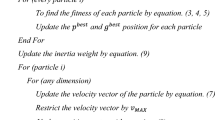Abstract
Kaniadakis entropy is a kind of generalized entropy based on the \( \kappa \) probability distribution, which has a good ability to deal with the distribution of long tail. The image thresholding algorithm based on Kaniadakis entropy can effectively segment images with long-tailed distribution histograms, such as nondestructive testing image. However, Kaniadakis entropy is a generalized information entropy with parameter. How to choose appropriate parameter \( \kappa \) is a problem to be solved. In this paper, we proposed an adaptive parameter selection Kaniadakis entropy thresholding algorithm. Based on a clustering effectiveness evaluation index, we transform the parameter selection problem into an optimization problem, then use particle swarm optimization search algorithm to optimize it and finally obtain the segmentation threshold under the optimal parameter. The presented algorithm can adaptively select parameters according to different images and obtain the optimal segmentation images. In order to show the effectiveness of the proposed method, the segmentation results are compared with several existing entropy-based thresholding algorithms. Experimental results both qualitatively and quantitatively demonstrate that the proposed method is effective.














Similar content being viewed by others
References
Angeline PJ (1998) Evolutionary optimization versus particle swarm optimization: philosophy and performance difference. In: Annual conference on evolutionary programming, San Diego
Arimoto S (1971) Information-theoretical considerations on estimation problems. Inf Control 19(3):181–194
Bhandari AK, Kumar A, Singh GK (2015) Tsallis entropy based multilevel thresholding for colored satellite image segmentation using evolutionary algorithms. Expert Syst Appl 42(22):8707–8730
de Albuquerque MP, Esquef IA, Mello ARG et al (2004) Image thresholding using Tsallis entropy. Pattern Recognit Lett 25:1059–1065
Devi H (2006) Thresholding: a pixel-level image processing methodology preprocessing technique for an OCR system for the Brabmi script. Ancient Asia 1:161
Ebergart RC, Shi YH (2001) Tracking and optimizing dynamic systems with particle swarms. In: Proceedings of congress on evoluztionary computation 2001, Seoul, Korea. IEEE Service Center, Piscataway, NJ
Eberhart RC, Kermedy J (1995) A new optimizer using particles swarm theory. In: Proceedings of 6th international symposium on micro machine and human science (Nagoya, Japan). IEEE. Service Center, Piscataway, NJ, pp. 39–43
Gonzalez RC, Woods RE (2007) Digital image processing, 3rd edn. Prentice-Hall, Englewood Cliffs
Kaniadakis G (2013) Theoretical foundations and mathematical formalism of the power-law tailed statistical distributions. Entropy 15:3983–4010
Kapur JN, Sahoo PK, Wong AKC (1985) A new method for gray-level picture thresholding using the entropy of the histogram. Comput Vis Graph Image Process 29:273–285
Li CH, Lee CK (1993) Minimum cross entropy thresholding. Pattern Recognit 26(4):617–625
Liu Y, Li S (2010) Two-dimensional arimoto entropy image thresholding based on ellipsoid region search strategy. In: International conference on multimedia technology. IEEE
Liu Y, Mu C, Kou W et al (2015) Modified particle swarm optimization-based multilevel thresholding for image segmentation. Soft Comput 19(5):1311–1327
Ng HF (2004) Automatic thresholding for defect detection. Pattern Recognit Lett 27(14):1644–1649
Nie F, Li J, Zhang P et al (2017) Threshold segmentation method of complex image based on Kaniadakis entropy. Laser Infrared 47(8):1040–1045
Otsu N (1979) A thresholding selection method from gray-level histograms. IEEE Trans Syst Man Cybern 9(1):62–66
Pal SK, King RA, Hashim AA (1980) Automatic gray level thresholding through index of fuzziness and entropy. Pattern Recognit Lett 1:141–146
Pun T (1981) Entropic thresholding: a new approach. Comput Graph Image Process 16:210–239
Sahoo P, Ilkins CW, Yeage J (1997) Threshold selection using Renyi’s entropy. Pattern Recognit 30(1):71–84
Sezgin M, Sankur B (2004) Survey over image thresholding techniques and quantitative performance evaluation. J Electron Imaging 13(1):146–165
Sparavigna AC (2015a) Shannon, Tsallis And Kaniadakis entropies In bi-level image thresholding. Int J Sci 4(2):35–43
Sparavigna AC (2015b) Bi-level image thresholding obtained by means of Kaniadakis Entropy. Int J Sci 4(1):41–49
Wang S, Chung FL (2005) Note on the equivalence relationship between Renyi-entropy based and Tsallis-entropy based image thresholding. Pattern Recognit Lett 26:2309–2312
Wang Z, Bovik AC, Sheikh HR et al (2004) Image quality assessment: from error visibility to structural similarity. IEEE Trans Image Process 13(4):600–612
Xie XL, Beni G (1991) A validity measure for fuzzy clustering. IEEE Trans Pattern Anal Mach Intell 13(8):841–847
Xiong FS (2014) Survey over image thresholding techniques based on entropy. Int Conf Inf Sci 2:1330–1334
Zhang L, Zhang L, Mou X et al (2011) Fsim: a feature similarity index for image quality assessment. IEEE Trans. Image Process 20(8):2378–2386
Acknowledgements
This work is supported by the National Natural Science Foundation of China (Nos. 61671377, 61601362, 61571361, 41874173) and the “New Star Team of Xi’an University of Posts and Telecommunications,” No. xyt2016-01.
Author information
Authors and Affiliations
Corresponding author
Ethics declarations
Conflict of interest
The authors Bo Lei and Jiu-lun Fan declare that they have no conflict of interest.
Ethical approval
This article does not contain any studies with human participants or animals performed by any of the authors.
Additional information
Communicated by V. Loia.
Publisher's Note
Springer Nature remains neutral with regard to jurisdictional claims in published maps and institutional affiliations.
Rights and permissions
About this article
Cite this article
Lei, B., Fan, Jl. Adaptive Kaniadakis entropy thresholding segmentation algorithm based on particle swarm optimization. Soft Comput 24, 7305–7318 (2020). https://doi.org/10.1007/s00500-019-04351-2
Published:
Issue Date:
DOI: https://doi.org/10.1007/s00500-019-04351-2




